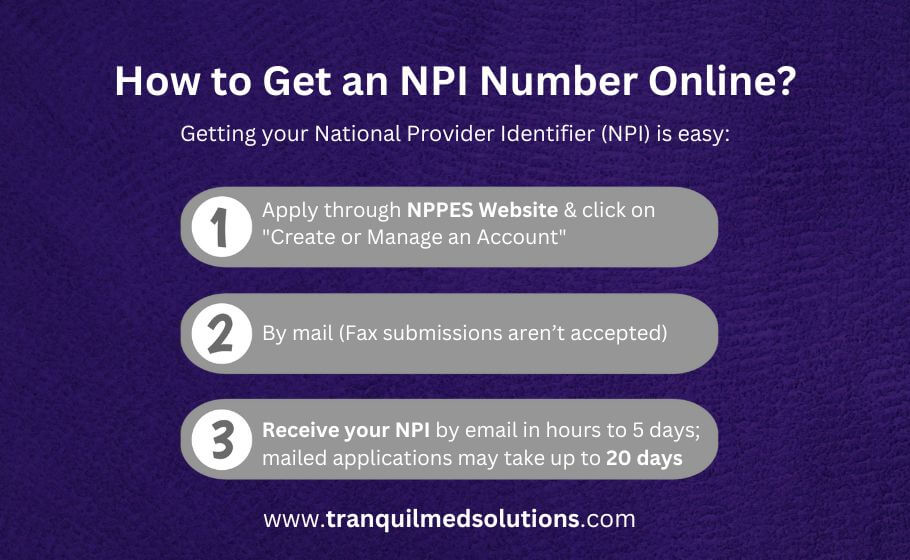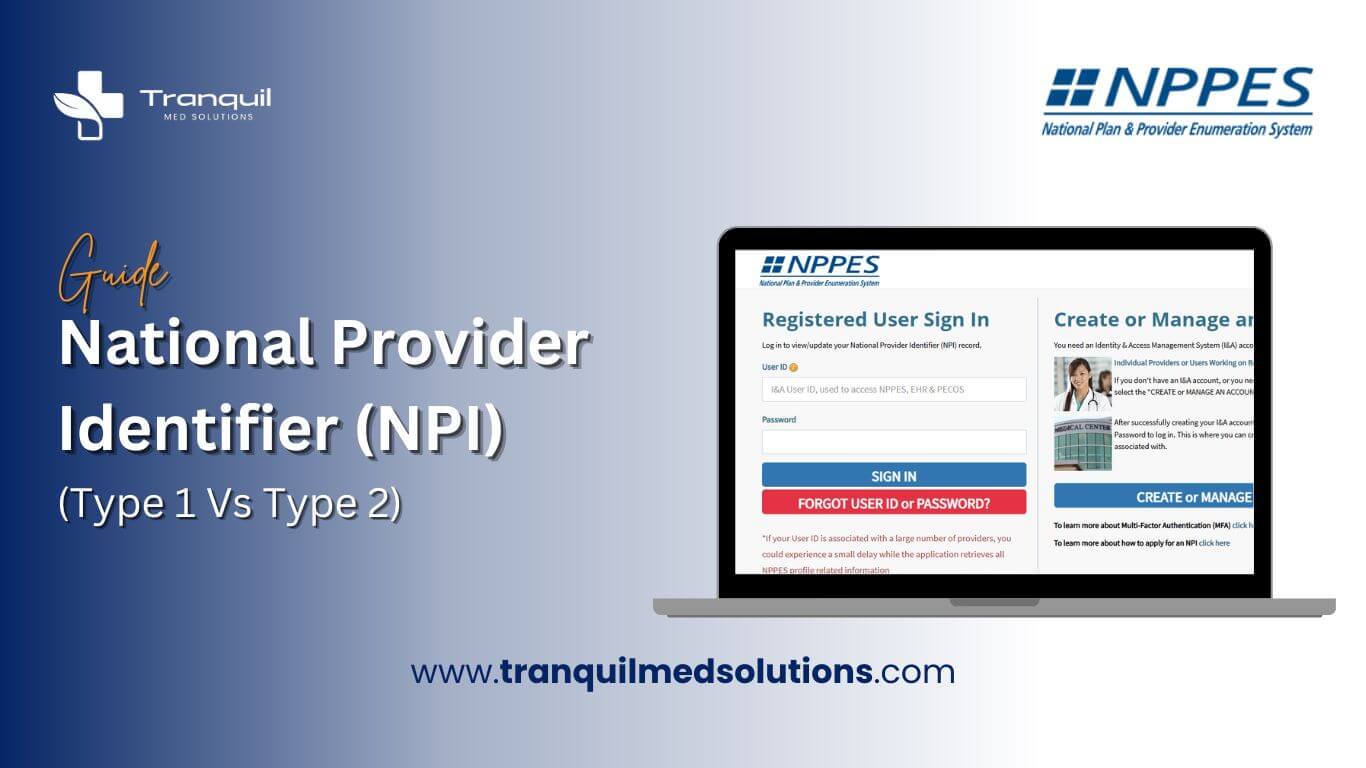Overview
Understanding the National Provider Identifier (NPI) is crucial for every healthcare provider. This article offers essential information and guidelines about NPI regulations and requirements.
What is the National Provider Identifier (NPI)?
The National Provider Identifier (NPI) is a unique 10-digit identifier assigned to healthcare providers in the U.S. by the Centers for Medicare & Medicaid Services (CMS). This number serves several purposes:
- License Type: Identifies your profession, such as social worker, professional counselor, or marriage and family therapist.
- License Level: Indicates whether you are provisionally, limited, or fully licensed.
- Specialty: Aids in specific credentialing and billing processes.
This guide from Tranquil MedSolutions highlights the differences between NPI types, helping you choose the right one for your practice. You’ll also discover who needs an NPI, its uses, and the application process.
About the NPI
Healthcare providers who electronically transmit health information in standard transactions must obtain an NPI, as required by HIPAA. The NPI system was created to provide a standardized identifier recognized by all payers. While having an NPI is essential for enrollment with health insurance companies, it does not automatically enroll you with them.
Since its inception, the NPI has become a vital requirement for both in-network and out-of-network billing. It is highly recommended that all providers obtain an NPI. According to Title 45 of the Code of Federal Regulations (CFR) Section 160.103, all healthcare providers and organizations are eligible for an NPI.
Key Features of NPIs:
- Unique Identifier: Each healthcare provider or organization receives a distinct 10-digit NPI.
- Random Generation: NPIs are randomly generated and do not contain any encoded information.
- Permanence: They are permanent identifiers that do not change or expire.
- Replacement: NPIs replace previous identifying numbers used in electronic transactions, such as Medicaid and legacy payer numbers.
- Not a Substitute: NPIs do not replace Social Security numbers, DEA numbers, taxpayer ID numbers, taxonomy numbers, or state license numbers.
All individual healthcare providers (including dentists) and organizations, such as clinics and group practices, can obtain an NPI through the National Plan and Provider Enumeration System (NPPES).
Who Needs an NPI?
If you answer “yes” to any of the following questions, you are a “covered entity” under NPI standards and must obtain one by federal law:
- Do you submit claims electronically?
- Do you use a clearinghouse?
- Do you submit claims attachments electronically?
- Do you verify eligibility or check claim statuses online?
The Value of an NPI to Your Practice
- Streamlined Transactions: Reduces the need to maintain multiple identification numbers for different payers.
- Flexibility: Allows you to relocate your practice or change specialties without needing new identifiers.
- Cost Efficiency: Simplifies healthcare transactions and helps reduce costs.
The Application Process

To apply for an NPI:
- Complete the NPPES Application: You can apply NPPES online or by mail (faxes are not accepted).
- Processing Time: Expect your NPI within 1-5 business days for online applications; mailed applications may take up to 20 days.
Reporting Your NPI to Insurance
After obtaining your NPI, check with your local insurance company about their preferred method for reporting it. Simply submitting it on a claim does not guarantee it will be entered into their system. Once reported, use it on claim forms that specifically require the NPI. If any information related to your NPI changes (e.g., name or address), update the NPPES within 30 days.
Type 1 vs Type 2: Choosing Your NPI
There are two NPI types: Type 1 and Type 2. Here’s how to determine which one suits your practice:
- Type 1 (Individual): For solo practitioners who receive payments in their name or under their Social Security number. If you’re a solo provider or a single dentist, a Type 1 NPI is sufficient.
- Type 2 (Organization): For group practices, incorporated businesses, or other entities paid under a business name with an Employer Identification Number (EIN). In a multiple-provider practice, each provider needs a Type 1 NPI, while the practice requires a Type 2 NPI for billing under its TIN.
Practical Application of Type 1 and Type 2 NPIs:
- Solo Practitioner: Use only Type 1 if claims are filed under your name and Social Security number.
- Individual at One Practice Location: Use Type 1 for yourself and Type 2 for your practice if claims are filed under the practice’s name and TIN.
- Multiple Providers, One Location: Each provider needs a Type 1 NPI, and the practice requires a Type 2 NPI if claims are filed under the practice’s name and TIN.
- Multiple Providers, Multiple Locations: Each provider needs a Type 1 NPI, and each practice location needs a Type 2 NPI if each location has a separate TIN.
Whether you’re an individual practitioner or part of a larger organization, selecting the correct NPI is vital for accurate billing and compliance with HIPAA. Ensure that your NPI details align with payer information to avoid claim denials or enrollment issues.
If you need assistance in determining whether to choose NPI Type 1 or Type 2, contact us for a free consultation with a healthcare growth specialist at Tranquil MedSolutions. We’ll help you select the right NPI type and streamline your billing process.
NPI Protection: Supervision & Credentialing
Once you receive your NPI, set up a login to manage and monitor its usage. Your Type 1 NPI is personal and should not be used by others unless permitted by payers. Most payers do not allow “incident to” billing, where services provided under supervision are billed under someone else’s NPI. Medicare has strict requirements regarding supervision billing, and Medicaid and private insurers may vary, so it’s crucial to confirm their policies.
During the credentialing process, follow each payer’s billing rules. Medicare prohibits billing until credentialing is complete, while some payers may allow provisional billing. Always adhere to payer guidelines to avoid misuse of your NPI.
Frequently Asked Questions
How to apply for NPI number online?
You can register for Type 1 and Type 2 NPIs through the NPPES site or use the NPPES NPI Registry to find established NPIs.
Where can I get help with the NPI application?
The NPI Enumerator provides application assistance and updates your information in the NPPES.
How is NPI number determined?
NPIs are randomly generated by the National Plan and Provider Enumeration System (NPPES), with no embedded coding for specific provider information.
Will the NPI affect other identifying numbers?
Yes, the NPI replaces other identifying numbers in electronic transactions, such as Medicaid and other legacy payer numbers.
However, it does not replace Social Security numbers, DEA numbers, or taxpayer IDs.
Do I need an NPI if I only submit paper claims and don’t use the internet to check eligibility?
No, but we recommend obtaining one for consistency in identification with all payers.
Can I be credentialed at multiple locations?
Yes. Just remember that varying network status at different employers can cause billing complications.
When should a provider apply for an NPI?
Consider the right timing for a provider to apply for an NPI, especially for residents and interns. While they may be eligible, they might only need an NPI if they submit claims. Medicare may require it for prescribing or referrals, and other payers may have different rules. Focusing on these nuances will help guide providers on when to apply.
Can you apply for NPI number without a license?
Some healthcare providers, such as medical billing professionals and IT experts, don’t need a license to obtain an NPI. Working in healthcare, they require an NPI to manage transactions and maintain records efficiently.
NPI number application cost?
An NPI number is free.
How to find the taxonomy code for NPI?
To locate your taxonomy code:
1. Go to the NPPES NPI Registry.
2. Enter your NPI Number.
Click “Search.”




